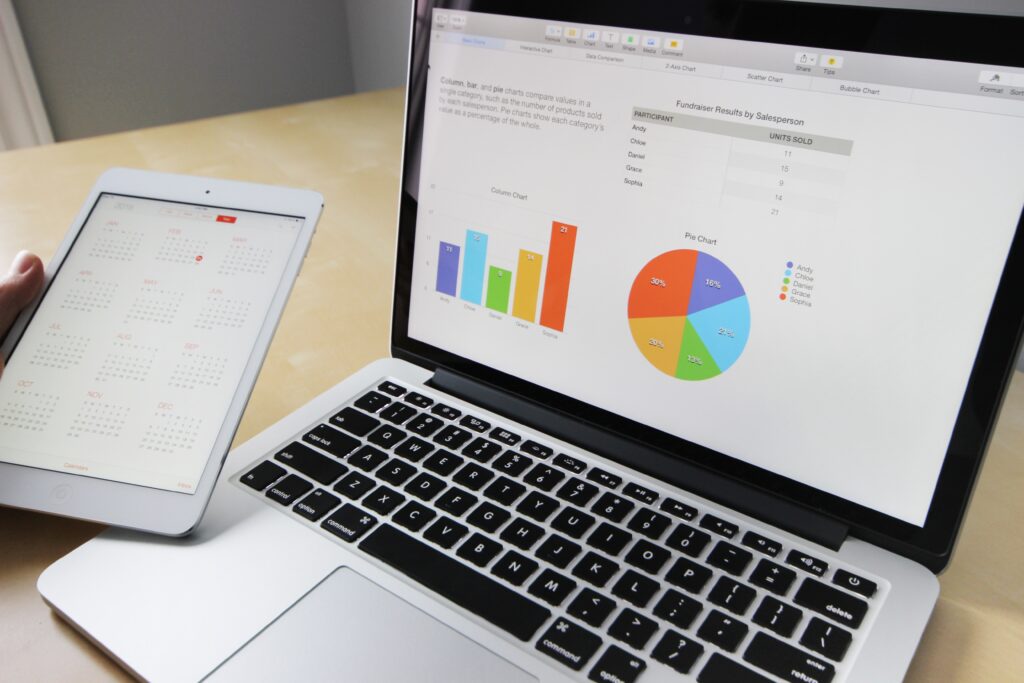
In the ever-evolving landscape of advertising, data and analytics have become crucial tools that shape the success of campaigns. Understanding the role they play is key to staying ahead in the competitive advertising game. By analyzing data and leveraging insights, advertisers can gain a deeper understanding of their audience, tailor their messaging, and optimize their strategies for maximum impact. In this article, we will explore the pivotal role that data and analytics play in advertising and how they empower advertisers to make informed decisions that drive results. So, buckle up and get ready to unlock the potential of data and analytics in the world of advertising!
Understanding the Role of Data and Analytics in Advertising
The Importance of Data in Advertising
Data plays a significant role in advertising by providing crucial insights that help businesses make informed decisions. In today’s digital age, vast amounts of data are generated every second, offering valuable information about consumers, their preferences, and their behaviors. By collecting and analyzing data, advertisers can gain a deep understanding of their target audience, enabling them to create more personalized and relevant advertising campaigns.
Data allows advertisers to identify trends, patterns, and correlations in consumer behavior. By examining data about customers’ demographics, interests, browsing history, and purchase behavior, advertisers can gain insights into what motivates their target audience and tailor their messaging accordingly. This allows for a more targeted and effective advertising strategy, maximizing the chances of reaching and engaging the right customers.
The Benefits of Data-Driven Advertising
Data-driven advertising offers numerous benefits for businesses. Firstly, it allows for more precise targeting, ensuring that advertising efforts are directed towards the most relevant audience. By utilizing data to identify specific demographics, interests, or behaviors, advertisers can deliver ads to the right people at the right time, leading to higher conversion rates and better return on investment.
Additionally, data-driven advertising enables advertisers to measure the effectiveness of their campaigns. With the help of analytics, advertisers can track key metrics such as click-through rates, conversions, and impressions. This data allows them to gauge the success of their advertising efforts and make data-backed adjustments to optimize future campaigns for even better results.
Data-driven advertising also enhances customer experience by delivering highly relevant and personalized advertisements. By utilizing data to understand customer preferences and purchase history, advertisers can create personalized ad experiences that resonate with their target audience. This not only improves customer satisfaction but also increases the likelihood of conversion and brand loyalty.

The Role of Analytics in Advertising
Analytics is the practice of interpreting and analyzing data to extract meaningful insights. In the context of advertising, analytics plays a vital role in understanding the effectiveness of campaigns, optimizing ad performance, and guiding advertising strategies.
Through analytics, advertisers can track various metrics related to their advertising campaigns. For instance, click-through rates (CTRs) help measure the percentage of users who click on an ad after seeing it. Conversion rates indicate the percentage of users who take a desired action, such as making a purchase, after interacting with an ad. Impressions measure the number of times an ad is displayed.
By analyzing these metrics, advertisers can gain insights into the effectiveness of their campaigns and make data-driven decisions to optimize their advertising strategies. Analytics allows advertisers to identify underperforming campaigns, test different variables, and make necessary adjustments to maximize their return on investment.
Key Analytics Metrics in Advertising
In advertising, several key performance indicators (KPIs) are widely used to measure the success of campaigns.
-
Click-through rate (CTR): CTR measures the percentage of users who clicked on an advertisement after viewing it. This metric helps assess the effectiveness of ad designs, copy, and placement.
-
Conversion rate: Conversion rate indicates the percentage of users who completed a desired action, such as making a purchase or filling out a form, after interacting with an ad. This metric helps measure the campaign’s ability to drive valuable actions.
-
Impressions: Impressions refer to the number of times an advertisement is displayed to users. This metric helps gauge the reach and exposure of a campaign.
-
Return on Ad Spend (ROAS): ROAS measures the revenue generated for every dollar spent on advertising. It helps assess the profitability and efficiency of advertising campaigns.
-
Cost per Acquisition (CPA): CPA measures the average cost incurred to acquire a new customer or lead. This metric helps evaluate the cost-effectiveness of advertising efforts.
By monitoring and analyzing these metrics, advertisers can gain valuable insights into the performance of their campaigns and make data-driven decisions to optimize their advertising strategies.

Leveraging Data and Analytics for Targeting
One of the primary advantages of data and analytics in advertising is the ability to enhance targeting capabilities. By leveraging data about consumer demographics, interests, and behaviors, advertisers can create highly targeted campaigns that reach the right audience at the right time.
Data allows advertisers to segment their audience based on various factors such as age, gender, location, interests, and purchase behavior. This segmentation enables advertisers to deliver personalized advertisements that resonate with different groups of consumers, increasing the chances of engagement and conversion.
Analytics further strengthens targeting capabilities by providing insights into the performance of different segments. By analyzing data related to each segment, advertisers can identify which segments are responding well to their advertisements and adjust their targeting strategies accordingly. This ensures that advertising efforts are focused on the most lucrative segments, maximizing the impact of the campaign.
Enhancing Ad Campaign Performance with Data
Data and analytics play a crucial role in enhancing the performance of advertising campaigns. By continuously monitoring and analyzing campaign metrics, advertisers can identify areas of improvement and make data-backed adjustments to optimize their ad campaigns.
For instance, by tracking the click-through rates of different ads, advertisers can identify which creatives are resonating with their audience and which ones are underperforming. This information allows them to refine their creative strategies and allocate resources towards the most effective ad designs.
Similarly, analyzing conversion rates can help identify potential issues in the conversion funnel. By examining data related to user behavior on landing pages, advertisers can identify bottlenecks or areas where users are dropping off. With this insight, they can optimize landing page design, introduce persuasive elements, or make other necessary adjustments to improve conversion rates.
Data also allows advertisers to perform A/B testing, where different versions of an ad are tested to determine which one performs better. By comparing the performance of different variables such as ad copy, visuals, or calls-to-action, advertisers can identify the most effective elements and refine their campaigns accordingly.

Using Analytics for Ad Testing and Optimization
Analytics plays a crucial role in ad testing and optimization, allowing advertisers to make data-driven decisions to improve campaign performance.
Through A/B testing, advertisers can compare the performance of different variables to identify the most effective combination. For example, they can test different headlines, images, or calls-to-action to determine which ones generate higher click-through rates or conversion rates. By systematically testing and iterating, advertisers can constantly optimize their campaigns for better results.
Additionally, analytics can help advertisers optimize their ad targeting. By analyzing data related to the performance of different audience segments, advertisers can identify those that are generating the highest engagement or conversion rates. They can then allocate more resources towards these segments to maximize the impact of their campaigns.
Analytics also enables real-time optimization. By continuously monitoring campaign metrics, advertisers can identify underperforming ads or segments and make immediate adjustments. This agility allows them to respond quickly to changing consumer behaviors or market dynamics, ensuring their campaigns remain effective.
Measuring Ad Effectiveness with Data and Analytics
Measuring ad effectiveness is crucial to assess the success and impact of advertising campaigns. Data and analytics provide advertisers with the necessary tools to measure and evaluate the effectiveness of their ads.
By tracking key metrics such as click-through rates, conversion rates, and impressions, advertisers can assess the performance of their campaigns. They can analyze whether their ads are generating sufficient engagement, driving desired actions, and reaching a relevant audience.
Analytics allows for deeper insights into the performance of ads by segmenting data based on various parameters. This enables advertisers to understand which demographics, locations, or interests respond best to their ads. By identifying the most responsive segments, advertisers can allocate resources more effectively and tailor their messaging accordingly.
Moreover, advanced analytics techniques such as multi-touch attribution enable advertisers to measure the impact of different touchpoints throughout the customer journey. This helps determine the contribution of each ad or marketing channel in driving conversions or sales.
By continuously measuring and analyzing ad effectiveness, advertisers can make data-driven decisions to improve their campaigns, optimize resource allocation, and generate better results.
Addressing Privacy and Ethical Concerns in Data-driven Advertising
As data-driven advertising relies on the collection and analysis of consumer data, it is essential to address privacy and ethical concerns to maintain consumer trust and compliance with regulations.
Transparency is key in data-driven advertising. Advertisers need to be transparent with consumers about the data they collect and how they use it. Providing clear and concise privacy policies, seeking consent for data collection, and allowing users to control their data preferences help establish trust between advertisers and consumers.
Adherence to privacy regulations, such as the General Data Protection Regulation (GDPR), is crucial in data-driven advertising. Advertisers must ensure they comply with applicable regulations regarding data collection, processing, and storage. This includes obtaining consent, implementing appropriate security measures, and providing users with the ability to opt-out or manage their data preferences.
Advertisers should also prioritize data security and take necessary measures to protect consumer data from unauthorized access or data breaches. This includes encryption, secure storage, and regular cybersecurity audits.
Ethical considerations must also be taken into account in data-driven advertising. Advertisers should avoid discriminatory practices, misinformation, or using data in ways that may harm individuals or infringe on their rights. Clear guidelines and ethical frameworks can help guide advertisers in using data responsibly and ethically.
By addressing privacy and ethical concerns, advertisers can foster trust with consumers, build positive brand reputations, and ensure compliance with regulations.
Challenges and Future Trends in Data and Analytics in Advertising
While data and analytics offer numerous benefits in advertising, there are also challenges to overcome and future trends to consider.
One of the challenges in data-driven advertising is the quality and accuracy of data. Advertisers rely on accurate and up-to-date data to make informed decisions. However, data sources can be prone to errors, inconsistencies, or biases. Advertisers need to invest in data quality assurance processes, data cleansing techniques, and validation mechanisms to ensure the accuracy and reliability of their data.
Another challenge is the ever-changing landscape of data privacy regulations. As governments and regulatory bodies continue to enact new laws and regulations, advertisers need to stay updated and adapt their practices accordingly. This requires ongoing compliance efforts, data governance frameworks, and partnerships with legal experts to navigate the complex regulatory landscape.
In terms of future trends, artificial intelligence (AI) and machine learning are expected to play a significant role in data and analytics in advertising. AI-powered algorithms can analyze vast amounts of data to discover patterns, trends, and insights that humans may overlook. This can help advertisers make more accurate predictions, automate campaign optimization, and deliver personalized ad experiences at scale.
The rise of smart devices and the Internet of Things (IoT) also presents new opportunities and challenges in data-driven advertising. With more connected devices generating data, advertisers can gain insights into consumer behaviors and preferences in real-time. However, this also requires advertisers to adapt their analytics capabilities to process and interpret data from diverse sources.
Additionally, the ethical use of data is expected to gain more prominence. Advertisers will need to prioritize data ethics, transparency, and accountability to address growing concerns about privacy and data misuse.
In conclusion, data and analytics play a critical role in advertising by providing valuable insights, enhancing targeting capabilities, optimizing ad campaigns, measuring effectiveness, and addressing privacy and ethical concerns. By leveraging data and analytics, advertisers can create more personalized, effective, and responsible advertising campaigns in an ever-evolving digital landscape.





